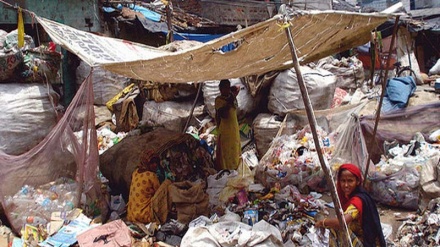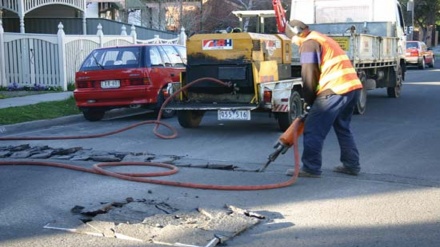We only have one planet to live on (20)
Today, we speak of air, as one of the factors, shaping the environment, which plays a major role in the existence of living creatures.
Air, in addition to water, food, heat, and light, are the five essential elements for continuation of the life of mankind. Every individual breathes roughly 22,000 times a day and is in need of nearly 15 kilograms of air per day. Man can live five weeks without food and five days without water, but cannot live for even five minutes without air. The air which we breathe is a combination of gases such as Nitrogen (78%), Oxygen (21%), Argon (0.9%), and Carbon Dioxide (0.03%). Air is necessary for the existence of animals, plants, and even microbes. Air, in addition to maintenance of the warmth of sunrays which reach Earth, protects Earth from the detrimental sunrays. However, as of the beginning of industrial revolution and amid the swift developments which the modern science and industry have shaped in the recent centuries, man has brought about air pollution. A rise in the amount of carbon emitted by factories that consume fossil fuels; or the carbon emissions of auto fuels and deforestation have induced air pollution and have threatened the health of creatures on Earth.
According to a report released by the World Health Organization in the year 2014, roughly seven million people have lost their lives in the year 2012 due to air pollution. Out of these seven million people, four million have died due to smoke resulting from combustion of fuels, and ovens at home. Another 3.7 million people have lost their lives due to air pollution in villages and cities. In some countries, the number of people who die due to air pollution exceeds the number of victims of driving accidents. The deaths resulting from air pollution are mainly related to ailments; such as asthma, bronchitis, shortness of breath, heart attacks, and allergies. Meanwhile, some people are more vulnerable to air pollution than others, such as children and the elderly.
Currently, many cities round the world are facing air pollution. According to the World Health Organization, air pollution reduces the life expectancy of residents of European cities by an average of nine months to two years. Based on estimations, mortality rate resulting from air pollution, surges by several folds in Athens in highly polluted days. Moreover, in Hungary, one out of every seventeen deaths is due to air pollution and its related consequences. Furthermore, the rate of mortality from cancer is 50% higher in regions, which suffer from intense air pollution, in comparison to the regions which maintain the least amount of air pollution.
Based on a body of research, air pollution negatively impacts the reproduction system, pregnancy, fetus, and infants. Also, based on recent researches, pollutants such as lead, sulfur dioxide, and smog play major parts in sterility of men. Pollutants such as carbon monoxide, sulfur dioxide, and smog highly and negatively impact fetus, and could lead to low weight of newborns.
Plants are also exposed to the consequences of air pollution. The studies carried out by environmentalists show existing air pollutants lead to closure of pores on plant leaves. Moreover, air pollution impacts plant leaves, which provide the necessary materials for trees and plants. In this manner, the necessary materials are not provided for trees and plants. The signs of plant poisoning by air pollutants can be observed in the form of wilted leaves or death of plant cells. In this manner, air pollution could lead to a fall in photosynthesis, reduction of the leaves’ surface, and inappropriate usage of water by trees and plants, in turn resulting in a reduction in flowers and fruits.
In view of experts, air pollution changes the air quality and is detrimental for humans and other living creatures, and even urban structures. As previously mentioned, air pollution in cities is a consequence of industrial revolution’s onset as of 300 years ago. Air pollution goes hand in hand with industrial growth and surging number of cities. The main reliance upon fossil energy sources such as coal, oil, and natural gas, and ultimately the emission of materials resulting from the combustion of fossil energy sources led to emergence of detrimental products which endanger living creatures, especially human beings. As of the early decades of 20th Century, and upon the observance of connection between air pollution and destruction of the environment, a number of advanced industrial countries started to carry out research to control several detrimental pollutants. However, unfortunately, an overwhelming number of developing countries are yet to take this issue of concern seriously, and air pollution continues to worsen in the large cities of these countries, day by day. Air pollution is a consequence of industrialization, and mainly due to rising number of cities and promotion of urban culture, traffic jams, swift economic growth, and mounting consumption of energy in other sectors.
The most important air pollutants that are emitted due to human activities are namely carbon monoxide, sulfur oxides, nitrogen oxides, and methane gas which are otherwise known as greenhouse gases. In addition to pollutant gases, smog also leads to air pollution. Smog consists of all minute liquid or solid particles which are scattered in the atmosphere and are of microscopic sizes. Smaller particles are even more dangerous, because they penetrate into human lungs. Some of them even enter the blood current, causing respiratory and cardiovascular ailments. These particles also settle on soil and water, polluting them.
One other important factor that causes air pollution in majority of large cities is the ozone gas next to the ground. The ozone gas is the product of the chemical reaction of pollutant gases which are emitted by autos, with sunlight. Ozone is a toxic gas which is further emitted in a warmer climate, and under sunrays. The existing ozone gas next to the ground should not be mistaken with the good ozone which is kilometers higher, in the upper layers of Earth’s atmosphere, which absorbs the detrimental ultraviolet rays.
Today, in order to assess air quality, the air quality index is used which is graded from naught to 500 based on the intensity of pollution. This index usually assesses the amount of ozone next to the ground and the suspended particles in air. It could also take into consideration the size of sulfur dioxide and nitrogen dioxide.
One of the dangerous impacts of air pollution, which has caused countless problems for the environment and the health of living creatures is the emergence of greenhouse gases.
MR/ME


